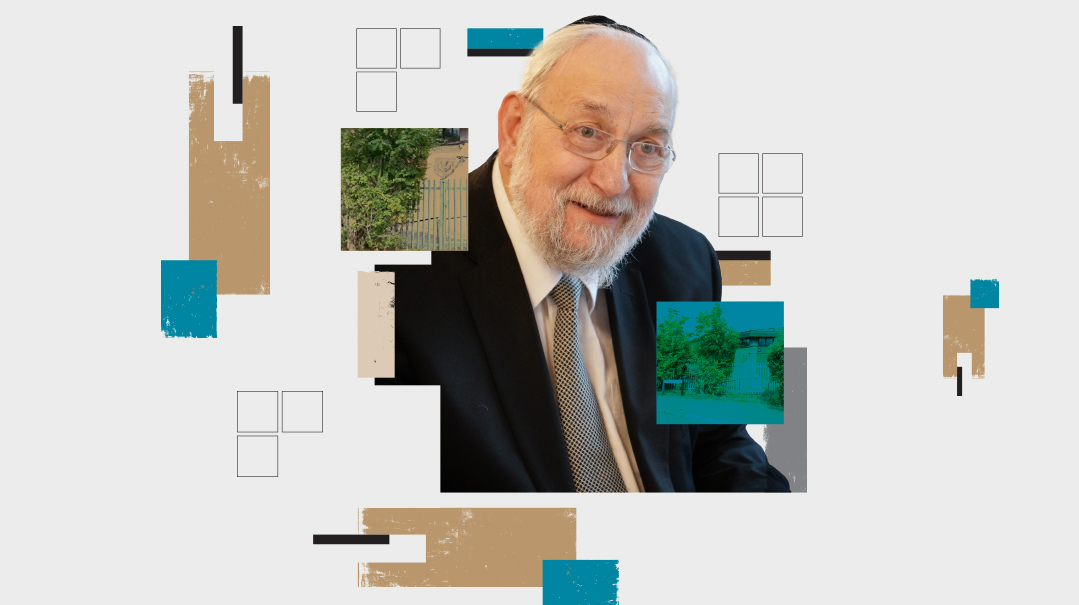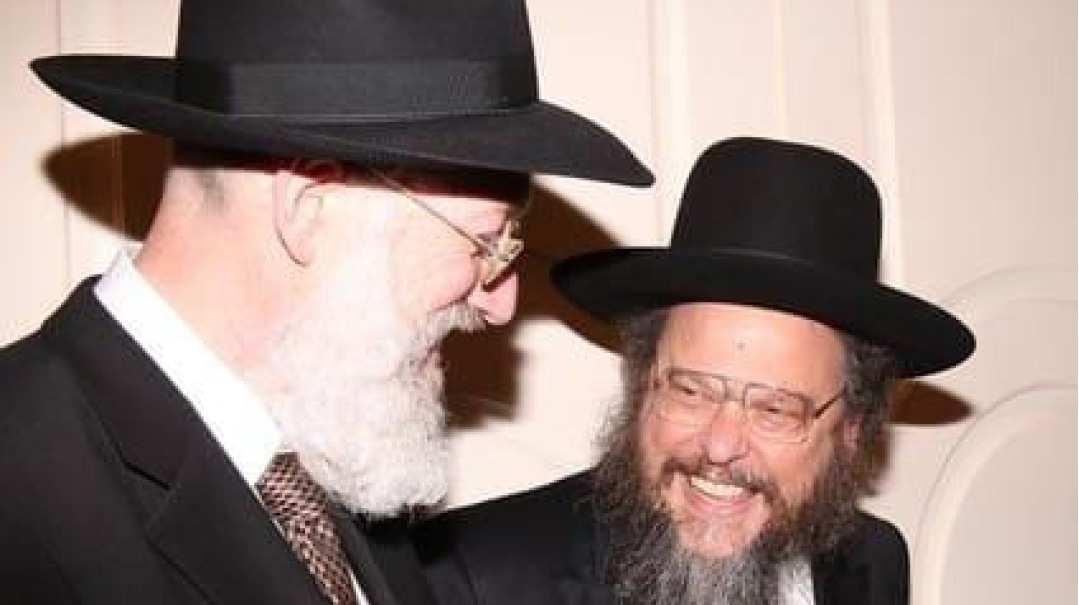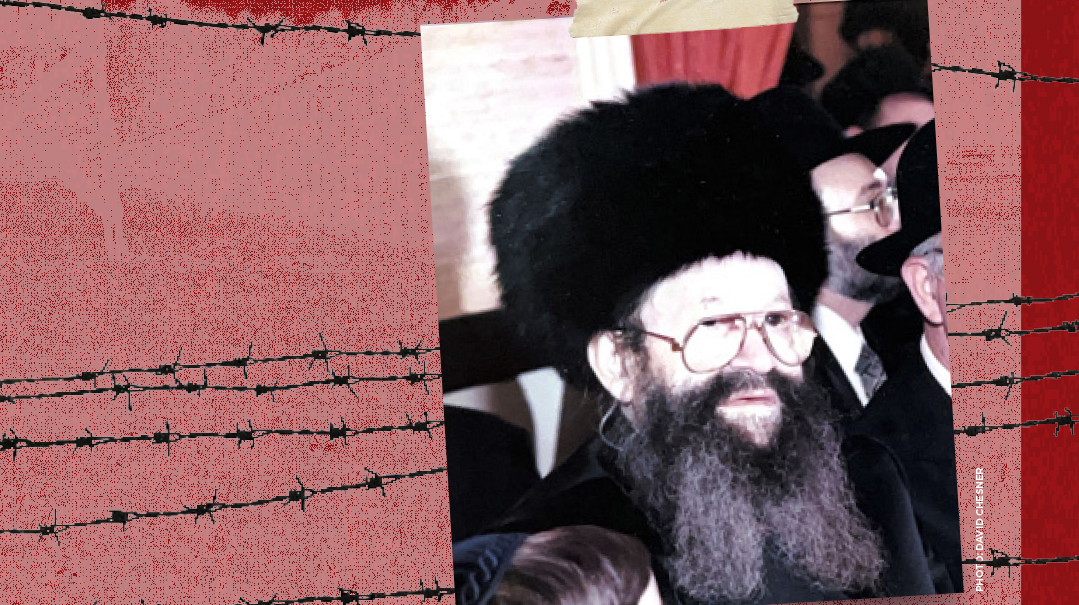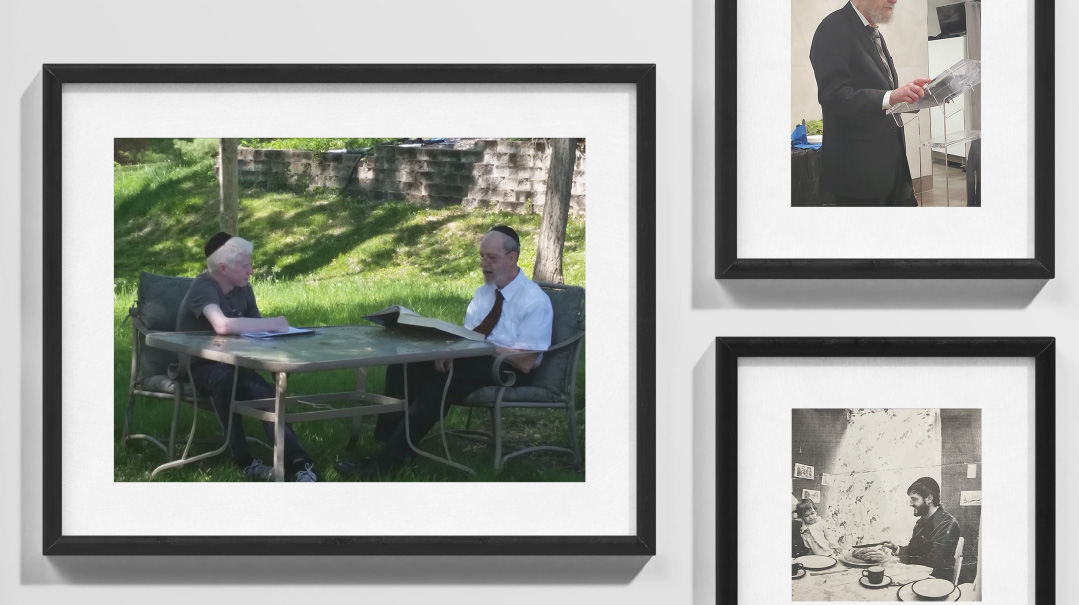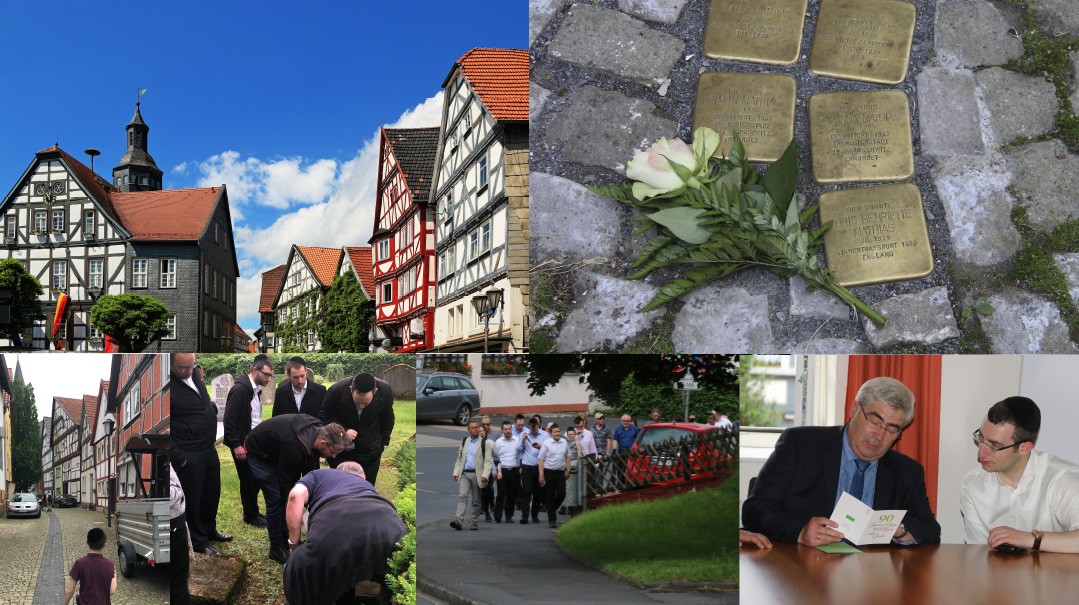Never About Him

It was then that I got a call asking if I‘d take on the job of writing a biography on Rav Nota Greenblatt
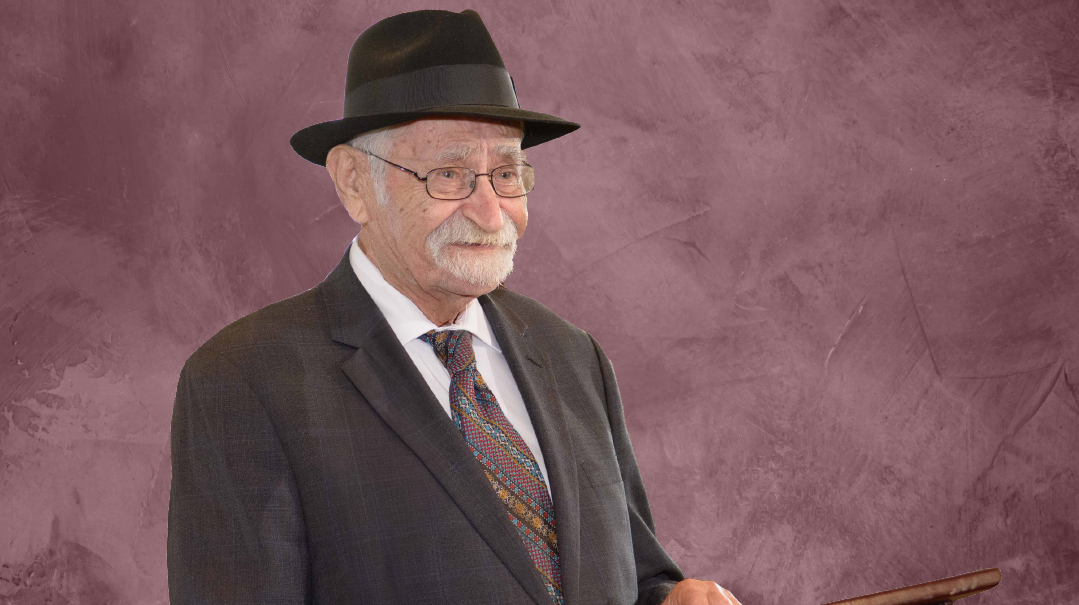
IF I thought writing a biography on Rav Nota Greenblatt would entail interviewing a few primary sources, I was wrong. Because Rav Nota was probably the least localized human being on earth, traveling wherever he was needed, often on a moment’s notice, crisscrossing the US on trains, planes and buses in order to help individuals and entire Jewish communities. It sounds cliché, but his story changed my life. With the imminent release of Rav Nota, maybe it will change yours, too
Full disclosure. I’m very much not the “my rebbi changed my life” kinda guy. That’s not necessarily a good thing, and I’m certain my wonderful rebbeim tried their best. But despite the sincerest inspiration, changing your life isn’t easy, and I never quite managed to hit the jackpot.
Until August of 2022.
It was then that I got a call asking if I‘d take on the job of writing a biography on Rav Nota Greenblatt, just a few months after his petirah at age 96. I accepted and worked diligently for a year and a half.
And it changed my life.
To be sure, I was already somewhat familiar with Rav Nota Greenblatt. In honor of his shloshim, Mishpacha featured an article on him titled “The Humblest Mountain” (Issue 912), which I had the privilege of writing. I was aware that Rav Nota, who was born in 1925, was a great talmid chacham and an exceptionally close talmid of Rav Moshe Feinstein. I knew that he spent several years in Eretz Yisrael where he developed relationships with the Brisker Rav, Rav Isser Zalman Meltzer, Chevron Rosh Yeshivah Rav Aharon Cohen, and many other Torah giants of that era.
And I heard much about how, rather than pursue a conventional path of rabbinic aspiration in a Jewish metropolis, in 1949 he headed down south and settled in Memphis, Tennessee, a temporary move that would become a permanent one. In Memphis, he taught in a Talmud Torah and built a day school where he served as the kindergarten and first grade teacher, taking no pay.
I heard how, with his incredibly sensitive heart, he would go well out of his way to help a Jew in need, particularly in the area of gittin. He would even fly out to prisons to procure consent from a man to divorce his wife and then fly to the woman’s hometown to have the get delivered — all without charging for his efforts. I had heard so many stories to these effects and so, when the book offer came in, I assumed the path forward would be clear-cut. The task, presumably, would be to do what I did for the article, just many times over.
I was wrong. I don’t know if there are any standardized rules on how a biography should be written, but, if there are, those rules don’t work for Rav Nota Greenblatt. Rav Nota was the least localized human being on earth. There was no one community, or institution, who could serve as a primary source of information on his life’s many accomplishments. For decades, Rav Nota traveled wherever he was needed, often on a moment’s notice, and no one but his wife knew his whereabouts. From New Orleans to Charleston to Atlanta and then Palo Alto, Rav Nota took trains and planes and buses throughout the United States, using his expertise in so many areas of halachah to help individual fellow Jews and entire Jewish communities.
This book, I soon realized, was going to entail a whole lot more than writing. It would require research and investigation and cold calls to phone numbers whose area codes I’d never seen before. There were plenty of false leads — “Rav Nota? Yes, he was here once, seemed like a special person….” And then there were the goldmines. It could be a Chabad shaliach in Myrtle Beach, South Carolina, or a rav in Tucson, Arizona, but those phone calls were like backed-up dams desperate for the bursting. The stories all shared the same magnificence: In one version or the other, Rav Nota was the brilliant talmid chacham who dressed with marked simplicity and managed to succeed where everyone else failed, and charged nothing for his efforts.
A picture began to emerge, but there was also mounting frustration. True, I was learning the stories of Rav Nota and the numerous roles he filled. But to write this book I needed more. I needed to know — not what he did — but who he was.
Who was Rav Nota Greenblatt? Why did he dress the way he did? Why did he do so much and ask for so little?
And here was the most important question. Why did interviewees invariably choke up when speaking about him? (This is not an exaggeration. More than once, an interviewee burst into tears mid-interview, and this was months after Rav Nota’s petirah.)
What about Rav Nota touched people so deeply?
The answer to all of it — and, I believe, a true depiction of Rav Nota’s essence — is one word: selflessness. Rav Nota was the most selfless of people. When the call came that a man who hadn’t given his wife a get in years would finally do so — tomorrow at noon in Phoenix, Arizona — Rav Nota was there. Not because he had nothing better to do, but because whatever he had to do was irrelevant. He, Nota Greenblatt, never came into consideration. Rav Nota cared about Hashem, His Torah, and His People.
But not about himself. It was never about himself.
Almost all of the myriad stories I heard carried an overtone of this quality. People cried when they shared these stories because they knew they were talking about someone who cared for them more than he cared for himself. That man is now gone — mi yiten lanu t’muraso — it is, indeed, a tragedy worth crying for.
I say that this experience changed my life. Cringey a cliche as it is, it’s actually not surprising. The one thing that will forever get in the way of spiritual growth is the prioritization of self-interest. So many times, we are confronted with options, and the choice will come down to “What works best for me?” Exposure to Rav Nota has made it that less easy to think in those terms. If only to a modicum of his degree, learning about Rav Nota can’t help but make one think twice before focusing on oneself.
The stories in this book are unique — both entertaining and awe-inspiring. But the important thing is not to lose the trees for the forest. Rav Nota accomplished incredible feats, but that wasn’t due to luck or good fortune. Rav Nota cared too much to fail and he was too selfless to resign.
The story of Rav Nota is the story of a man who cared more about you than he did for himself. As such, I am certain you will enjoy it.
The following are excerpts from the soon-to-be-released Rav Nota (ArtScroll/Mesorah) by Shmuel Botnick
Tenth Man
In 1953, Rav Nota received a phone call from Dr. Joseph Kaminetsky, the national director of Torah Umesorah. He was impressed by Rav Nota’s success in Memphis and asked that Rav Nota work his magic for a different community in the South. Although it was home to a large number of Jewish immigrants, it had no Hebrew day school.
Rav Nota arrived there at the beginning of the week, ready to give it his all. His first stop was the rabbi’s office. Rav Nota approached and asked his permission to recruit families for a Hebrew day school. The rabbi looked at him and laughed. “The parents want nothing to do with the old country,” he said. “They want their sons to be American boys, with a proper education.” Rav Nota stood his ground, insisting that it was worth a try. Finally, they came to an agreement: “Get ten families to sign up for the school by Friday,” the rabbi said, “and it’s yours.”
Rav Nota had less than one week to recruit ten families to commit to sending their children to a Hebrew day school that did not yet exist. He went from door to door, begging, pleading for the families to send their children. It was the heat of the summer. He was thirsty and famished but, uncertain of the kashrus standards, ate only fruit. Undeterred, he continued on. Friday came and Rav Nota showed up in shul exhausted but triumphant. Waving a sheet of paper at the rabbi, he proudly declared, “I have your ten applications!” The rabbi, who did not want the school established, turned white.
“Who are the ten?” he asked. “What are their names?”
“After Shabbos,” Rav Nota replied. “We’ll speak after Shabbos.”
On Motzaei Shabbos, Rav Nota arrived at the rabbi’s home, the precious list clutched tightly in his hand. The rabbi took the list and began going through it, name by name. Suddenly, he stopped.
“This family doesn’t count!” he said fiercely, pointing to one of the names. “They live on the other side of the tracks, in the poor neighborhood. They don’t even have a floor in their home. He doesn’t belong with the other children.”
Rav Nota left, broken. He came home and repeated the story to his wife, who, too, was devastated. “Nota,” she said, “when the time comes, I will put these applications in your grave.”
Rav Nota replied, “If Hashem needs to see these applications to know what I did, we’re toasted oats.”
Postscript: A few years later, a day school was successfully established in that city. And years after that, when Bill Clinton was elected president of the United States, Rav Nota came across a list of the Clinton administration’s staff members in the newspaper. One of the names looked familiar. As he reached back into his memory, he realized that this was the name of the tenth child on the list! The child who would have attended the school had it been allowed to open.
Rav Nota managed to track down the phone number of this man. He called him and congratulated him on his recent appointment. And then he told him one more thing. “I just want you to know,” he said, “that you were almost sent to a Jewish day school.”
What’s the Question?
Rav Nota spent the years from 1942 until 1945 in Mesivta Tiferes Yerushalayim (MTJ), studying under Rav Moshe Feinstein. During this time, the two grew quite close, and Rav Nota spent much time in the Feinstein home, where the phone rang constantly with a plethora of halachic questions. It was Rav Nota’s responsibility to answer the phone and present the questions to Rav Moshe. But at some point, Rav Moshe appointed Rav Nota to take on an additional role: “If you know the answer to the question,” Rav Moshe told his talmid, “answer it yourself. If you can’t answer it yourself, come to me.”
The phone rang and Rav Nota picked up. The caller, who spoke with a rich Polish accent, asked to speak with Rav Moshe.
“Rav Moshe is not available,” said young Nota. “What’s your question?”
The caller demurred, explaining that he really wanted to speak with Rav Moshe.
“Try me out,” said Nota. “If I don’t have the answer, I’ll ask Rav Moshe.”
The man wasn’t giving in easily. “What’s your name?” he wanted to know.
“Greenblatt.”
“How old are you?”
“Nineteen.”
“Are you married?”
“No.”
“Okay, I’ll ask you the question.”
The fellow went on to dissect his question and 19-year-old Rav Nota rattled out a rapid and brilliant response.
“Zeir gut, very good,” said the caller, and then, “Zug Rav Moshe az Hutner hut gerufen — tell Rav Moshe that Hutner called.” It was none other than Rav Yitzchok Hutner, rosh yeshivah of Yeshivas Rabbeinu Chaim Berlin.
The following day, the phone in Rav Moshe’s home rang again. It was the same familiar voice. This time, however, he did not request to speak with Rav Moshe. “Iz Greenblatt duh? Is Greenblatt there?” Rav Hutner wanted to know. Rav Nota answered in the affirmative, and the two discussed various topics in halachah. The same thing repeated itself for the next several days, and that’s how Rav Nota developed his own relationship with Rav Hutner.
Is It Kosher?
Each year before Succos, Rav Nota went to New York to purchase sets of arba minim. He brought them back to Memphis, where they were sold from his home. It was shortly before Succos, and Rabbi Yehudah Kaplan happened to be in Rav Nota’s house when a man entered Rav Nota’s study, a small lulav in his hand. “Rabbi,” he said proudly, “a family member bought me this lulav in Israel. All the way from Israel it comes! I wanted to show it to you and make sure it’s kosher.” Rav Nota, who typically examined a lulav and issued a ruling within seconds, took the minuscule lulav and his forehead creased in concentration. He reached for a sefer and began turning the pages, clearly struggling to obtain a clear answer. Rabbi Yehudah Kaplan stood to the side, watching. Something about the scene made no sense. If Rav Nota was struggling with this question, the likelihood of this lulav being perfectly fit for the mitzvah was slim. There was a box filled with kosher lulavim on the floor right beside Rav Nota. Why wouldn’t Rav Nota simply advise the man not to use his questionable lulav and instead, take a substitute from the box?
Then Rabbi Kaplan understood. In an instant, Rav Nota recognized how proud this man was of his lulav. It had been given to him as a gift and came all the way from Eretz Yisrael! Should Rav Nota rule that it was not kosher, the man would be crushed. For Rav Nota, sparing a fellow Jew from disappointment was a top priority. And so, before offering any alternative, he opted to take the time and effort to see if there were any way to rule that the lulav was kosher.
“Call Rav Nota”
Rav Nota was so much more than a halachic authority, because to him, every Yid was an entire world.
As a young boy, Rav Yisroel Yeshaya Kivelevitz frequently knocked on Rav Nota’s door and asked if they could learn together. “Sure!” Rav Nota always replied, “what do you want to learn?” The answer could vary: Mishnayos Zevachim or Gemara Bava Kamma, but the scene that followed was always the same. Yisroel Yeshaya opened his sefer and began to read, and Rav Nota sat across from him with no sefer at all. Rav Nota listened intently, nodding along and correcting the boy on any missed word or grammatical nuance. After Yisroel Yeshaya’s bar mitzvah, his father, together with Rav Nota, determined that he’d be best off in Telshe Yeshiva of Cleveland.
A few months passed. Yisroel Yeshaya was doing well in yeshivah but, as the only boy from Memphis, was struggling to find his feet socially; many of his classmates had been together since elementary school. It was 1963, shortly after a fire had ravaged the Telshe dormitory, and the students were housed in the yeshivah’s gym. At one point, Yisroel Yeshaya called his father and described how he enjoyed the learning in the yeshivah but was struggling socially. A few days later, during lunch hour, the door swung open and a tall, distinguished man stepped inside. The boys stopped and stared. Who was this man? Yisroel Yeshaya turned as well and gave a sudden leap. “Rabbi Greenblatt! Why are you here?”
Rav Nota spoke softly. “Your father told me you were going through a hard time so I decided to pay you a visit.” Rav Nota spent some time in the yeshivah, talking to Yisroel Yeshaya, his friends, and some staff members. For Yisroel Yeshaya, it was the beginning of years of successful learning. “I owe whatever Torah I have to Rav Nota Greenblatt,” Rav Kivelevitz says today.
Mrs. Shari Schwartz and her husband lived over a mile away from Rav Nota’s home and didn’t really have a connection with him. About a year after their marriage, she gave birth to a baby boy. But days later, the baby suffered a cardiac arrest and was rushed to Le Bonheur Children’s Hospital. The doctors took the baby and said that they would call “when it was over.” “In those days,” Mrs. Schwartz explains, “they wouldn’t let you hold or even see the baby. They just sent us home.”
It was two a.m. when the Schwartzes returned home. They called Rabbi Hillel Belsky, whose classes they attended. “Call Rav Nota,” he advised. “He’ll answer the phone now.” The phone rang and Rav Nota answered immediately. Mrs. Schwartz explained what had happened, and Rav Nota said, “I’ll take care of everything.” He gently explained what would happen, then rushed to the hospital, signed a stack of procedural documents, and took possession of the deceased baby. He phoned the Schwartzes and explained that they needed to give the baby a Jewish name, and suggested that it be Yisrael. The parents agreed. Rav Nota performed a bris, gave the baby his name, and took him to the Beth-El Emeth cemetery, where he dug a grave and buried the child with his own two hands. Over the next few days, Rav Nota made repeated visits to the Schwartz’s home, offering comfort and encouragement.
The Schwartzes would eventually be blessed with eight children. Rav Nota was the mohel for four of their sons, his shining face revealing a level of joy reserved for those who know how to feel another’s pain. But their relationship wasn’t limited to that. “Rav Nota came by to visit for years, until we eventually moved to Brooklyn,” says Mrs. Schwartz. “We lived over a mile away, but he’d often come by — on Shabbos, on Yom Tov — just to check up on us and wish us well.”
Shame Doesn’t Count
Rabbi Shmuel Khoshkerman, rabbi of the Ner Hamizrach congregation of Atlanta, Georgia, had to preside over a get with a unique layer of complexity, and so he called Rav Nota to enlist his help.
“I’ve never dealt with this particular issue either,” Rav Nota responded, “but we’ll figure it out.”
Rav Nota arrived in Atlanta, bringing along a sefer that outlined the requirements for precisely this scenario. After studying its contents intensely, Rav Nota began to write the get. After the get was written and delivered, Rav Nota headed to the Khoshkerman home where he would be staying until the following morning. Together, he and Rabbi Khoshkerman ate supper, went to daven Maariv, and then returned home. Rav Nota wished Rabbi Khoshkerman a good night and went to the guest room where he was to spend the night. Rabbi Khoshkerman headed off to bed as well.
Suddenly, he awoke with a start. Someone was banging furiously on his bedroom door. Bleary-eyed, he looked at the clock. It was three a.m. “Wake up!” a familiar voice was shouting. “Wake up! We have to do the get again!” Rabbi Khoshkerman stumbled to the door to find a pajama-clad Rav Nota, his eyes burning with concern. “I’ve been thinking about the get for the last few hours,” he explained. “I decided that we did it wrong. Please wake up both the man and the woman. Plus, we need another witness as well.” “But it’s three o’clock in the morning!” Rabbi Khoshkerman protested. “I can’t possibly wake them up!” Rav Nota acquiesced but, at seven o’clock the next morning, Rabbi Khoshkerman, along with Rav Nota, headed out to wake up the relevant parties and rewrite the get.
When Rav Nota was writing one of his last gittin, in St. Louis, Missouri, the woman who was to receive the get refused to participate in the procedure should it take place in any institution that segregated men from women. This ruled out any shul or kollel that would typically be used for a religious procedure of this nature. However, the woman agreed to meet with Rav Nota and the witnesses on the outdoor patio of FroYo, an ice cream parlor just down the road from the Agudas Israel shul of St. Louis. Rav Nota arrived, witnesses in tow, and they took their seats as cappuccino-sipping patrons looked on curiously. After going through the halachic procedures, Rav Nota placed the get in the woman’s hands. She grasped it, then drew her arm back and hurled it at Rav Nota’s face. The get ricocheted and landed on Delmar Boulevard. Saying nothing, Rav Nota, who was over 90 years old, stepped into the busy street, bent down, and retrieved the get — a belittling task for anyone, and especially a man of his stature. He then returned to the patio, where the slightly sullied get was unfolded and read out loud, as required by halachah.
Unchained
Rav Nota was persistent in demanding that a certain recalcitrant husband give his wife a get, but the man wasn’t budging. Finally the man said, “Rabbi, if you meet me at two o’clock on Erev Yom Kippur I’ll agree to have you write a get.” Rav Nota, who served as the baal tefillah on Yom Kippur, agreed with no hesitations. Erev Yom Kippur he packed up a few pieces of bread, some fish, a machzor, a volume of the Rambam which dealt with the laws of Yom Kippur, and he set out on the road to this man’s location. Even after he arrived, the man refused to authorize the get. Rav Nota spent hours talking to him until he finally consented, appointed Rav Nota to write the get, and signed the minui document. Mission accomplished, Rav Nota returned to his hotel room with ten minutes left to eat a rapid Seudah Hamafsekes, and there he remained for the next 25 hours — Rav Nota, his machzor, and a Rambam. When Rav Nota shared this story he added, “That Yom Kippur, I conceived novel Torah insights on these halachos of the Rambam, the likes of which I’d never been able to be mechadesh before.”
There was one experience that Rav Nota would share with a trembling voice, even decades after the event: It began when Rav Nota was asked to intercede on behalf of a woman who had been trying to procure a get from her husband for 13 years. Rav Nota found out from the Jewish Federation that the man worked as a shoe salesman in a Memphis department store. He called the man and asked if they could meet and arrange for a get to be written and delivered. “Sure, Rabbi, why not?” he said genially. “But I work very late. I can’t be there before eleven o’clock.” “Perfect,” Rav Nota deadpanned. “That’s when we open our office.”
Rav Nota arranged for the two witnesses to wait for him at the Anshei Sphard shul. They waited. At one-thirty in the morning, Rav Nota instructed one of the witnesses, an elderly man, to go to bed. At two in the morning, the shoe salesman called, apologized, and explained that he had “gone to the wrong side of town.” “Stay where you are,” Rav Nota replied. “I’ll come to you.” “No, no, Rabbi, it’s fine, I’m on my way.” At three a.m., the phone rang again. “Rabbi, I’m sorry but my car broke down.” “That’s fine,” said Rav Nota cooly. “Tell me where you are and I’ll come pick you up.” “Oh, no, Rabbi, no need to do that. I have someone here, he’s fixing the car.” At four a.m. the door opened and the man stepped inside. Rav Nota immediately set to work, writing the get as the sun began creeping over the horizon. He finished it at six in the morning.
Later, a letter arrived at the Greenblatt’s home. It was from the woman whom Rav Nota had freed, and she had written to thank him. The letter described how, thanks to Rav Nota’s efforts, she was able to remarry and pursue her lifelong dream of bearing a Jewish child. Rebbetzin Greenblatt read the letter and cried. “This will go in the coffin with you after 120 years,” she said to her husband.
Many years passed. Rav Nota was visiting a well-known yeshivah when he was approached by one of its students. “Are you Rabbi Greenblatt from Memphis?” the bochur asked. Rav Nota replied in the affirmative. “I think you’re the one who helped my mother receive a get many years ago.” Rav Nota asked a few personal details and understood that this was the son of the woman from the pre-dawn get.
“She remarried after the get,” the bochur said, “and had one child — me.” Rav Nota was taken aback. “And how is your mother doing?” he asked. “My mother? I just finished saying Kaddish for her.”
A Little Detective Work
Whether it came naturally to him or was a Divine gift, Rav Nota was a sleuth par excellence. There was a situation in which a woman needed a get but, as it turned out, she wasn’t the only one searching for her husband. For one reason or another, the FBI, Interpol, and the Israeli Mossad were all looking for him, too. While their efforts bore no fruit, one rabbi in Memphis was able to track him down.
“I got hold of his mother,” Rav Nota explained, “and I convinced her to reveal to me her son’s whereabouts. I knew how deep a Jew’s connection to his mother is.”
Rav Nota liked to share about the time he learned that a runaway husband was employed as a cook in a casino in Las Vegas. Rav Nota flew to Vegas and trekked from casino to casino, looking for the man. Finally, he entered one particular casino where they told him that, indeed, the man in question worked. He ran the morning shift in the kitchen and would be there at four a.m.
“Perfect,” said Rav Nota. At dawn the next day, Rav Nota went back to the casino to confront a rather surprised cook who ultimately consented to give his wife a get. In addition to this accomplishment, Rav Nota gained an insight. “When I went there in the evening, there was a group playing cards. When I returned the next morning, the same group was still playing cards! If I had such diligence in my learning I could have become like Rav Akiva Eiger.”
A keen understanding of human nature played a crucial role in Rav Nota’s success rate. He once learned of a man who had married and then quickly left town after draining his wife’s financial resources. He did not give her a get. The man then moved to another large city and did the same thing, though using a different name. Thus, two women were left halachically bound to a man whose whereabouts — and name — were a complete mystery. Rav Nota shared this story with a few bochurim, explaining how he found the fellow and managed to get two gittin out of him. “I figured that after he left, he was likely to move on to another city with a Jewish community and try the same shtick. I also heard that in the previous cities in which he lived he had served as the gabbai of a shul. I therefore assumed that, wherever his next destination was, he’s likely to be a gabbai there as well — a gabbai bleibt a gabbai [a gabbai remains a gabbai]. “Over the next few months, in whichever city I found myself, I would ask, ‘is there a new gabbai in town?’ Finally, the rabbi of a certain shul said, ‘Yes! There’s a new gabbai in town and, not only that, he’s engaged to be married to a woman from the community.’ The rabbi even told me that he was set to be the mesader kiddushin at their wedding.”
Rav Nota expressed his fears about who this individual might be, and the rabbi arranged a meeting. Sure enough, Rav Nota guessed right. This was the man he had been looking for. Rav Nota prevented the upcoming marriage from happening while simultaneously managing to procure consent to divorce the two previous wives as well.
Our Primary Self
As the years passed and his acclaim as a brilliant posek spread, the demands on Rav Nota’s time were stretched to the limits. And still, he managed to learn. On buses to Alabama, on flights from California, through cities, states, countries, and continents, Rav Nota remained immersed in learning. His ever-present attaché case carried a few precious seforim, and he once explained that there was a science behind it. It happened when Rav Nota was in Palo Alto, California, where he had spent the bulk of the day writing several gittin. Upon completion of the last get of the day, Rav Nota paid a visit to the Palo Alto kollel, where he delivered an impromptu shiur with his trademark brilliance, a whirlwind of Rambams and Raavads, spinning like leaves on a windy autumn day.
When the last of his questions was answered and the crowd dissipated, Rabbi Yitzchak Feldman, rabbi of Congregation Emek Beracha of Palo Alto, presented a question of his own. “How is it,” he asked, “that the Rav is able to spend hour after hour writing gittin and then immediately deliver such an incredible shiur?” Rav Nota explained that three times a day at the end of Shemonah Esreh, we pray “V’sein chelkeinu b’sorasecha,” a request that Hashem grant us our portion in Torah. “What does it mean when we request our ‘cheilek’ in Torah?” Rav Nota asked, and then explained, “it means our primary self. We ask Hashem that, no matter what it is that we do, the Torah should be our true portion, it should be our foremost identity. My cheilek,” he told Rabbi Feldman, “is in Torah.” It was a three-word explanation for a 90-year phenomenon; no matter how weary, how traveled, or how busy Rav Nota was, he continued to learn. Torah was his cheilek.
(Originally featured in Mishpacha, Issue 988)
Oops! We could not locate your form.

